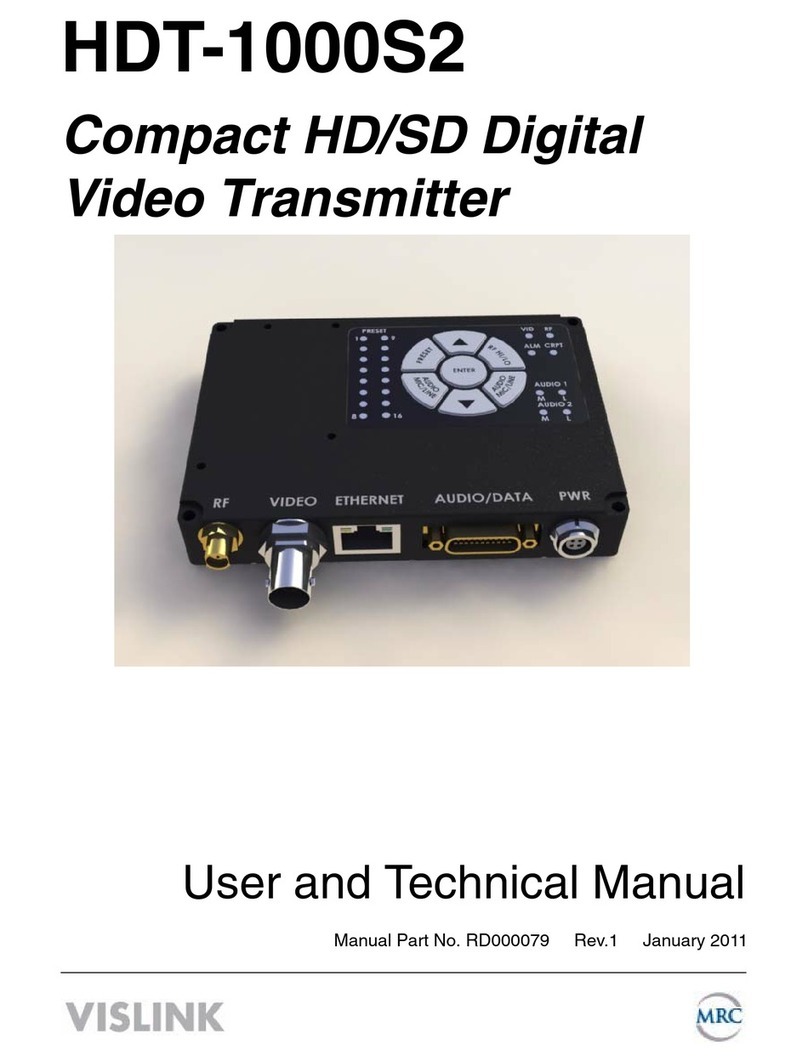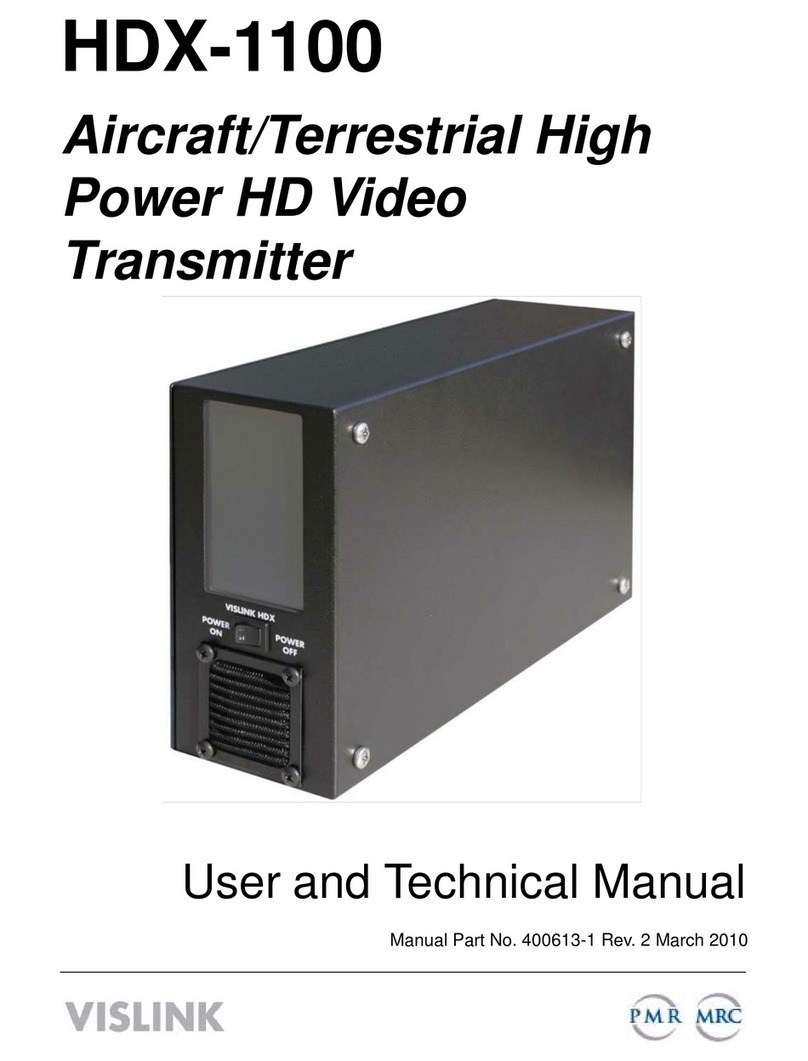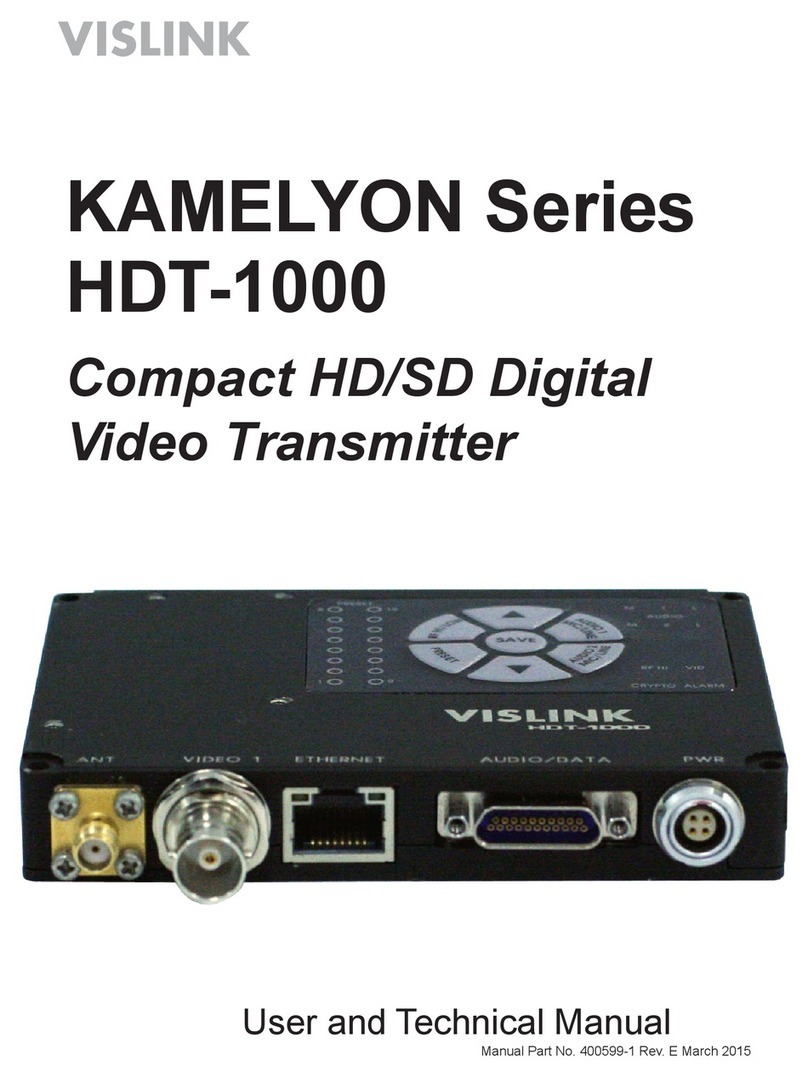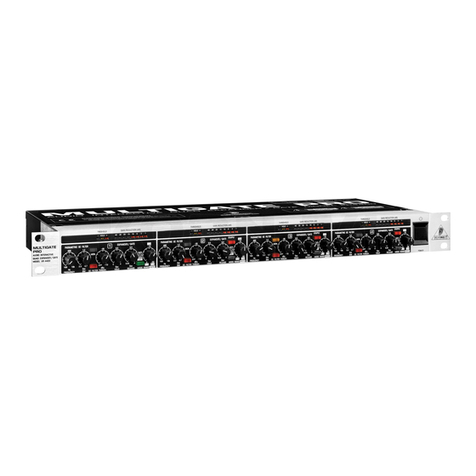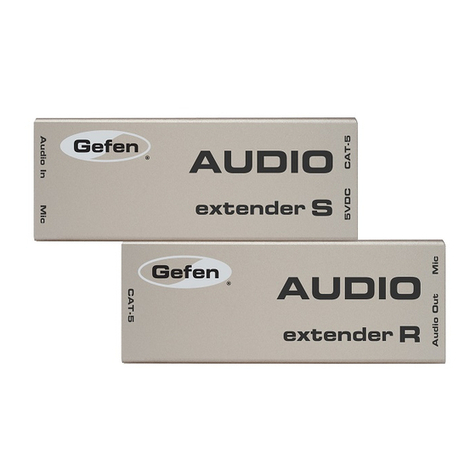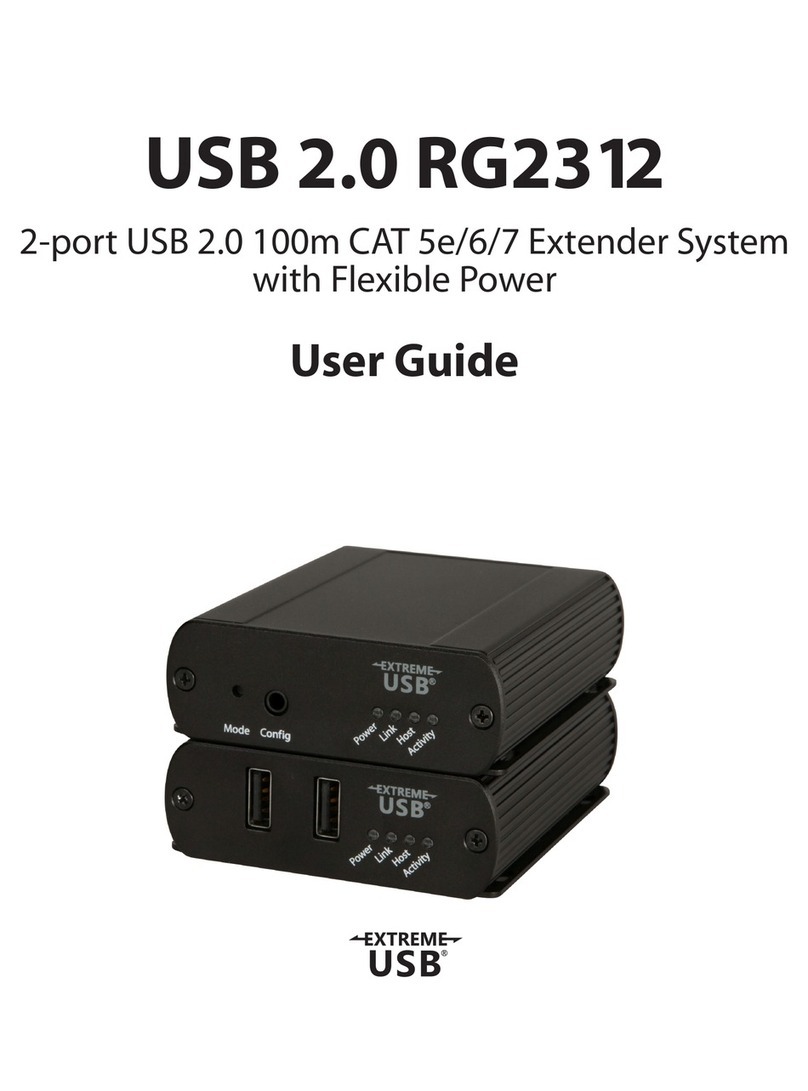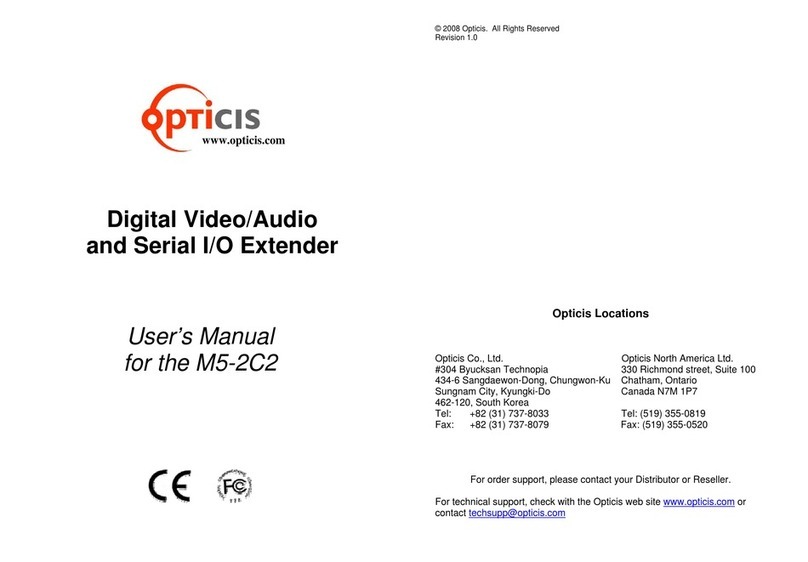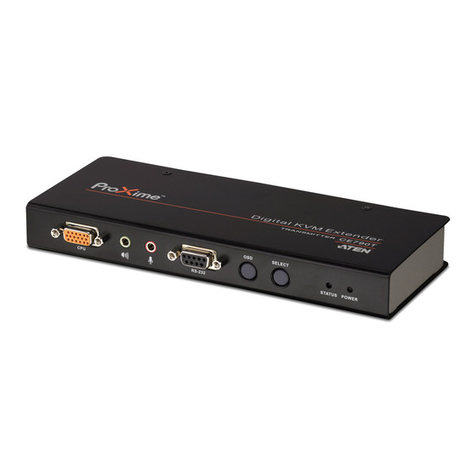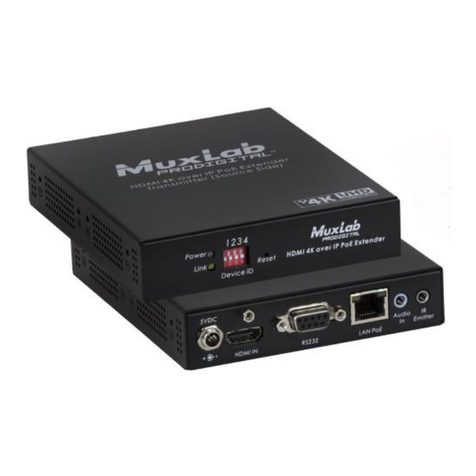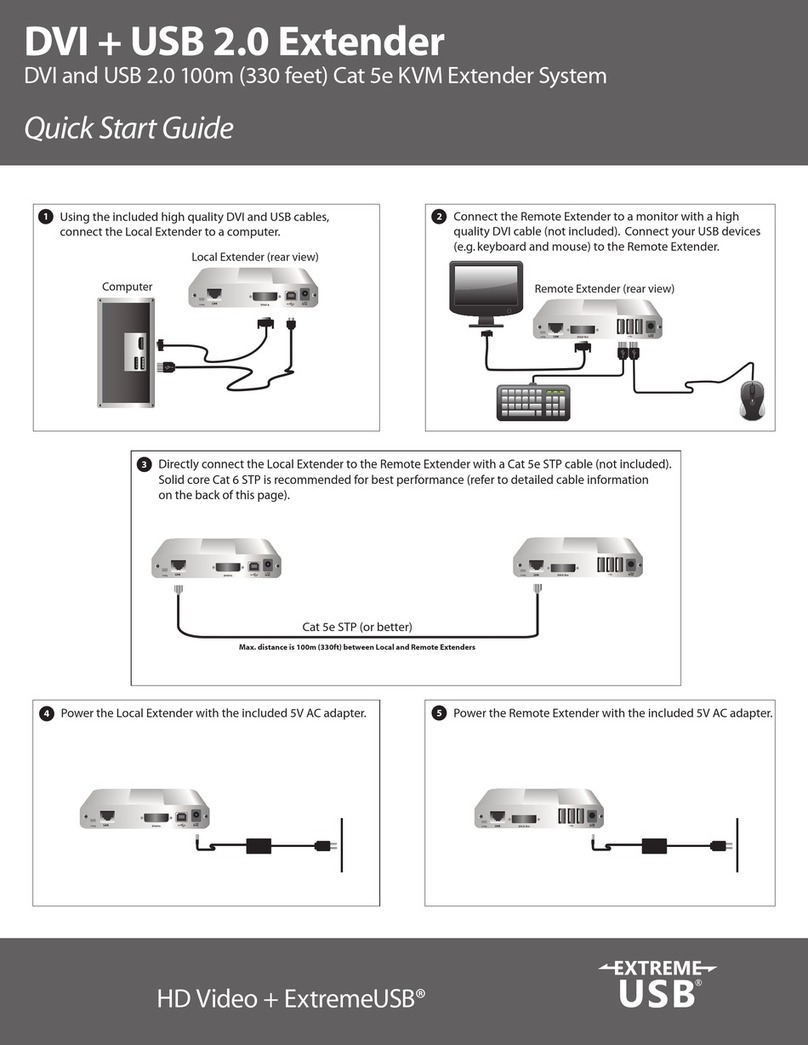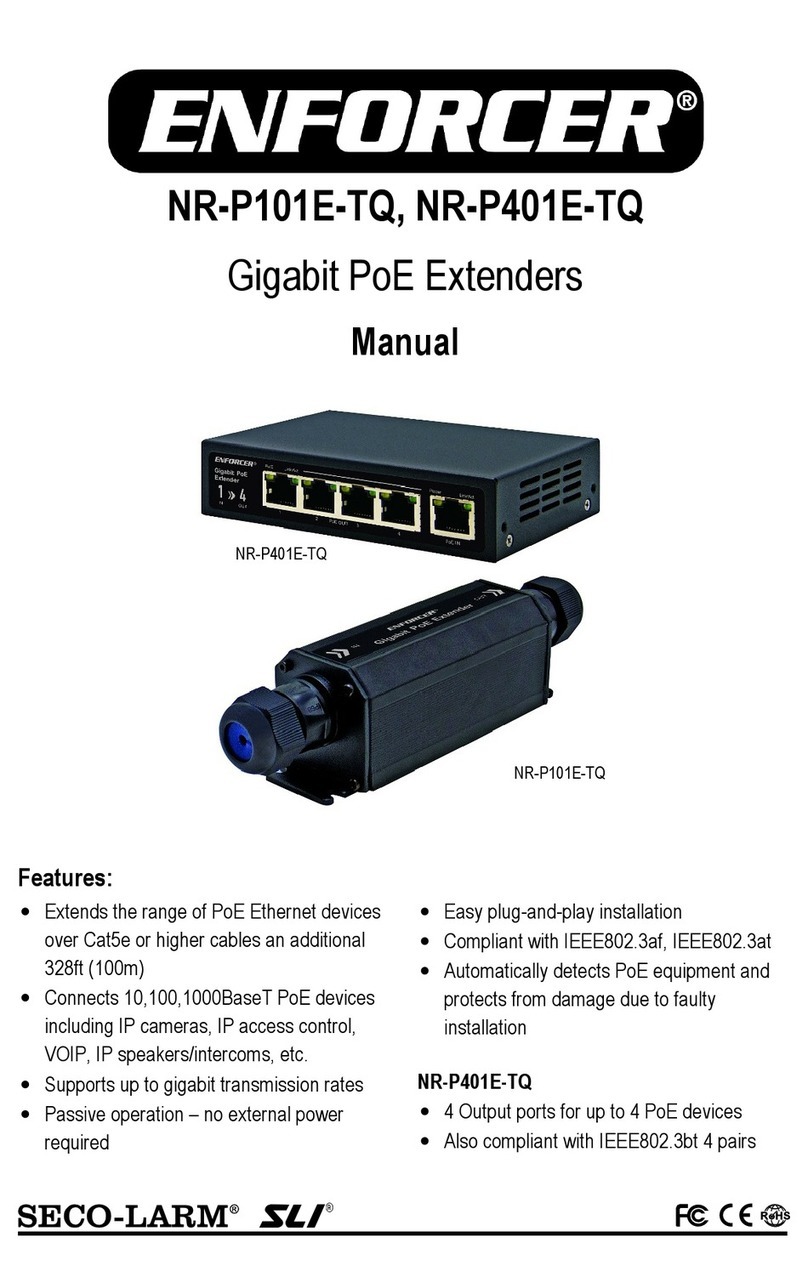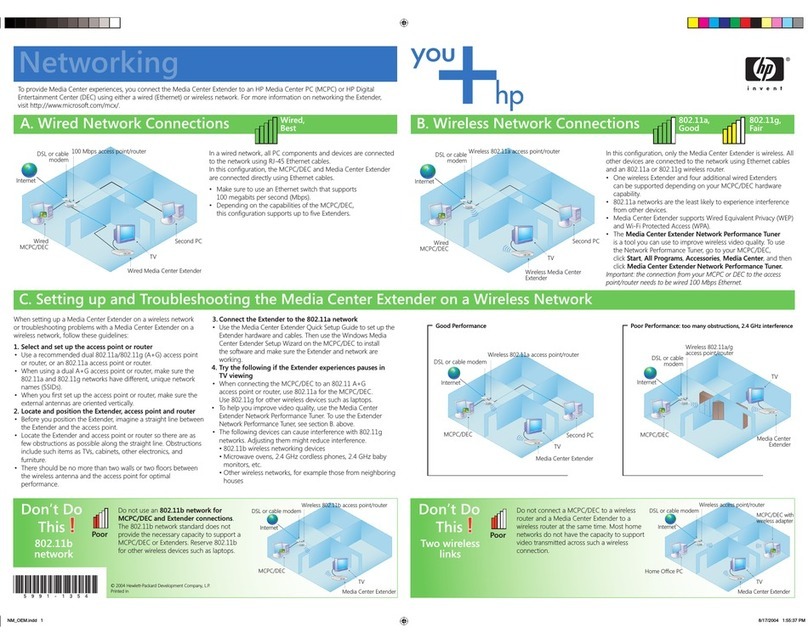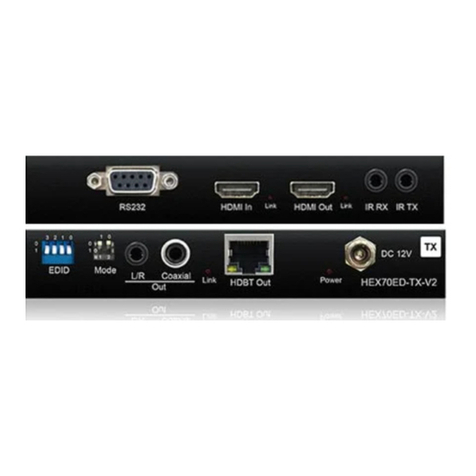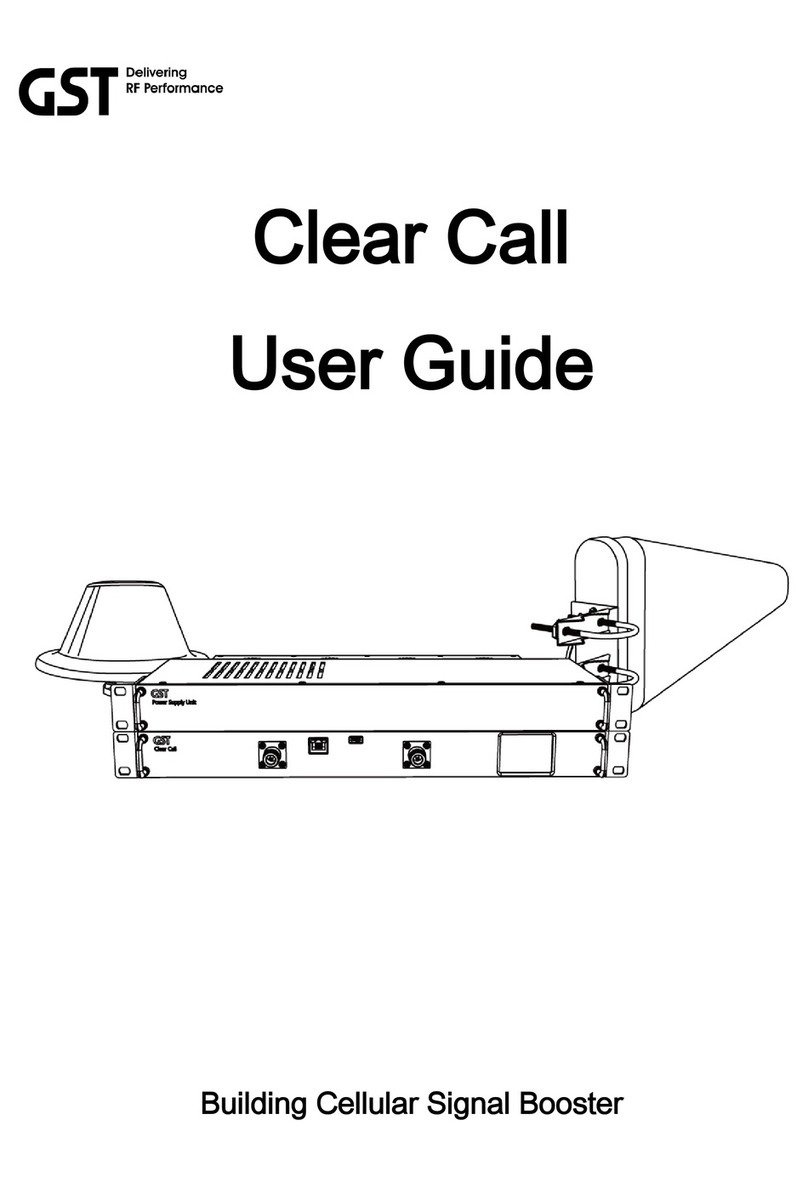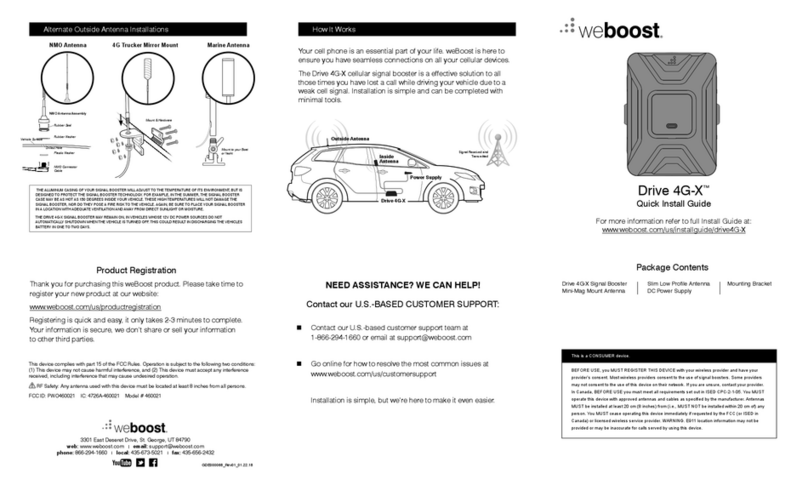Vislink Microlite 3 User manual

Microlite 3
HD Ultra Compact
Wireless Video System
Camera Transmission System

Operators Manual
Document Information
M55-ML3-UG, Rev A
ii
1. Document Information
1.1. Document Disclaimer
The information contained in this manual remains the property of VISLINK and may not
be used, disclosed, or reproduced in any other form whatsoever without the prior written
permission of VISLINK.
VISLINK reserves the right to alter the equipment and specification appertaining to the
equipment described in this manual without notification.
This document is supplied on the express terms that it is to be treated as confidential and
that it may not be copied, used, or disclosed to others for any purpose except as
authorized by VISLINK.
1.2. Conventions
NOTE: Notes show to convey additional information. where potential equipment
damage could occur.
CAUTION: Cautions show where potential equipment damage could occur.
WARNING: Warnings show where there is potential for personal danger or risk of
death. Read all warnings and understand them before carrying out work on
any equipment. This includes peripherals and any related equipment in
use. The danger is real and not reading and understanding the warning
could lead to injury, harm, or potential death.
1.3. Service/Support Contacts
Region
Contact Details
Worldwide
UKsupport@VISLINK.com
+44 (0) 1442 431410
Americas
+1 978 330 9292
When contacting Technical Support, please include the following information:
•Model number and serial number of the unit (located on a label on the bottom of each
unit).
………………………………………….
•Approximate date of purchase.
………………………………………….

Operators Manual
Document History
M55-ML3-UG, Rev A
iii
2. Document History
Version
Date
Modification
Firmware Version
A
6/26/2020
First release of document.
n/a

Operators Manual
Document History
M55-ML3-UG, Rev A
iv
Table of Contents
Document Information.................................................................................................... ii
Document Disclaimer...................................................................................................................................................ii
Conventions .........................................................................................................................................................................ii
Service/Support Contacts.......................................................................................................................................ii
Document History ............................................................................................................ iii
Safety Information............................................................................................................ 7
General Information...................................................................................................................................................... 7
Disposal Instructions.................................................................................................................................................... 7
Environmental................................................................................................................................................................... 7
Health & Safety.................................................................................................................................................................8
Maximum RF Power Density Limits.................................................................................................................9
Introduction .......................................................................................................................10
Product Description ....................................................................................................... 11
Features and Benefit ..................................................................................................................................................11
Frequency Bands and Power ..............................................................................................................................11
Power Consumption................................................................................................................................................... 12
Wi-Fi Controller.............................................................................................................................................................. 12
Transmitter Electrical Description...................................................................................................................12
Specifications ...................................................................................................................14
Frequency Bands and RF Performance.....................................................................................................14
Modulation Modes.......................................................................................................................................................14
MPEG Encoder................................................................................................................................................................14
Control...................................................................................................................................................................................15
Wi-Fi Wireless Web page .....................................................................................................................................15
Power Requirements.................................................................................................................................................15
Environmental.................................................................................................................................................................15
Altitude..................................................................................................................................................................................16
Physical Characteristics...........................................................................................................................................16
Installation .........................................................................................................................17
Overview..............................................................................................................................................................................17
Physical Description...................................................................................................................................................17
Outline Drawing .............................................................................................................................................................17
Ship Kit and Accessories ........................................................................................................................................18
Physical Installation ....................................................................................................................................................18
Connectors.........................................................................................................................................................................18
Power Serial Port Connections (Item 5)......................................................................................................19
Antenna Connection .................................................................................................................................................20
Connecting Power......................................................................................................................................................20
Operation............................................................................................................................21
Power Up the Microlite 3........................................................................................................................................21
Using the Local User Interface to Control the Microlite 3...........................................................22
Power settings from OLED Display............................................................................................................... 24
SCAN Feature................................................................................................................................................................. 25
Using the Web Page to Control the Microlite 3.................................................................................. 26
Connecting to the Web Page............................................................................................................................ 26
Home Page Features.................................................................................................................................................27
Transmission Mode.................................................................................................................................................... 28

Operators Manual
Document History
M55-ML3-UG, Rev A
v
Device Status.................................................................................................................................................................. 28
TX-Settings Page.........................................................................................................................................................30
Transmit Settings…………………………………………………………………………………………………………………………………………………………………….30
Channel Selection………………………………………………………………………………………………………………………………………………………………….31
Modulation Selection………………………………………………………………………………………………………………………………………………………….31
Manual Settings………………………………………………………………………………………………………………………………………………………………………..31
Advanced Settings ......................................................................................................................................................32
Baud Rate……………………………………………………………………………………………………………………………………………………………………………………….32
Telemetry……………………………………………………………………………………………………………………………………………………………………………………….32
Encryption (Optional) ………………………………………………………………………………………………………………………………………………………….32
Frequency Plan Page................................................................................................................................................32
Edit a Frequency………………………………………………………………………………………………………………………………………………………………………33
Adding a New Frequency to the List…………………………………………………………………………………………………………………..33
Unit Info Page................................................................................................................................................................. 33
Telemetry........................................................................................................................................................................... 34
Equipment Required................................................................................................................................................. 34
MicroLite 3 Connectors........................................................................................................................................... 35
Set-Up .................................................................................................................................................................................. 36
Operation............................................................................................................................................................................ 37
Remote Control Application ................................................................................................................................41
Manage Transmitters ................................................................................................................................................41
Manage Selected Transmitters........................................................................................................................ 42
Remote Control Action Keys.............................................................................................................................. 42
Remote Control............................................................................................................................................................. 43
Remote Control Commands............................................................................................................................... 43
Usage Examples………………………………………………………………………………………………………………………………………………………………………45
Example 1 - To Request Unit Model Number……………………………………………………………………………………………45
Example 2 - To Request Unit Serial Number……………………………………………………………………………………………..45
Alarm Reporting............................................................................................................................................................46
Alarm Example………………………………………………………………………………………………………………………………………………………………………….46
Table of Figures
Figure 1: MLT3 Functional Block Diagram ..............................................................................................13
Figure 2: Outline Drawing .....................................................................................................................................17
Figure 3: MLT3 Connectors.................................................................................................................................18
Figure 4: Power and Serial Lemo Mating Connector .....................................................................19
Figure 5: Powering up Microlite 3.................................................................................................................... 21
Figure 6: Green LED indicators and OLED Display............................................................................22
Figure 7: No Video Input Sensed and RF is on Standby ...............................................................22
Figure 8: User Interface Wire Frame ............................................................................................................23
Figure 9: Local User Interface ............................................................................................................................23

Operators Manual
Document History
M55-ML3-UG, Rev A
vi
Figure 10 User Interface - Shadowing Shown on Parameters being Changed or
Set…………………………………………………………………………………………………………………………………………………………………………………………………………..24
Figure 11: Joystick for Control............................................................................................................................ 24
Figure 12: HI, LO, STB Power setting on the OLED Display ....................................................... 25
Figure 13: Last Power Setting............................................................................................................................. 25
Figure 14: Microlite 3 Rebooting from Hibernate............................................................................... 25
Figure 15: DFS Scan Feature............................................................................................................................... 26
Figure 16: Clear channel number is displayed on the screen ................................................. 26
Figure 17: Webpage Connection via Wi-Fi.............................................................................................27
Figure 18: Home Page (RF Transmission in Standby) ....................................................................27
Figure 19: Power Modes ....................................................................................................................................... 28
Figure 20: MLT3 Device Status........................................................................................................................ 29
Figure 21 - Microlite 3 Options Menu........................................................................................................... 29
Figure 22 - Microlite 3 Transmitter Settings Page (Tablet View)...........................................30
Figure 23 - Microlite 2 Channel Drop-down Menu............................................................................31
Figure 24 –Microlite 2 Frequency Plans .................................................................................................. 33
Figure 25: MLT3 Connectors ............................................................................................................................. 35
Figure 26: MLT3 RC and CC Typical Set Up with Direct Connect.......................................36
Figure 27: MLT3 Camera Control with Fiber Extension ............................................................... 37
Figure 28: Adding MicroLite to RC Application.................................................................................. 38
Figure 29: Adding new Transmitter............................................................................................................. 38
Figure 30: Retrieving MLT3 Status from RC Application............................................................ 39
Figure 31: Applying Parameter Using the RC Application.........................................................40
Figure 32: Saved Presets......................................................................................................................................40
Figure 33: Remote Control Tab Sections .................................................................................................41
Figure 34: Clamshell Goldmount Assembly Instruction ............................................................. 47
Figure 35: Clamshell V-Clip Assembly Instruction..........................................................................48
Figure 36: L-Bracket Goldmount Assembly Instruction ............................................................. 48
List of Tables
Table 1: Features and Benefits..........................................................................................................................11
Table 2: MLT3 Frequency Bands, Power and Power Consumption ..................................12
Table 3: MLT3 Connectors...................................................................................................................................19
Table 4: Power/Serial Connector Pinout................................................................................................20
Table 5: Focal Point Telemetry Radio Selection............................................................................... 34
Table 6: MLT3 Camera Control Kit ............................................................................................................... 35
Table 7: MLT3 Connectors.................................................................................................................................. 35
Table 8: Remote Control Applications Settings ................................................................................ 42

Operators Manual
Safety Information
M55-ML3-UG, Rev A
7
3. Safety Information
3.1. General Information
To ensure awareness of potential hazards, all personnel concerned with the operation or
maintenance of the equipment must study the information that follows, together with
local site regulations.
WARNING: RF Power Hazard: High levels of RF power are present in the unit.
Exposure to RF or microwave power can cause burns and may be harmful to
health. Switch off supplies before removing covers or disconnecting any RF
cables, and before inspecting damaged cables or antennas.
WARNING: Avoid standing in front of high gain antennas (such as a dish) and
never look into the open end of a waveguide or cable where RF power may be
present.
CAUTION: Users are strongly recommended to return any equipment that
requires RF servicing to VISLINK.
WARNING- GaAs / BeO Hazard: Certain components inside the equipment
contain Gallium Arsenide and Beryllium Oxide that are toxic substances. Whilst
safe to handle under normal circumstances, individual components must not be
cut, broken apart, incinerated, or chemically processed. In the case of Beryllium
Oxide, a white ceramic material, the principal hazard is from the dust or fumes,
which are carcinogenic if ingested, inhaled or entering damaged skin.
Please consult your local authority before disposing of these components.
CAUTION: Tantalum Capacitors: When subjected to reverse or excess forward
voltage, ripple current or temperature these components may rupture and could
potentially cause personal injury.
CAUTION: This system contains MOS devices. Electro-Static Discharge (ESD)
precautions should be employed to prevent accidental damage.
3.2. Disposal Instructions
WARNING: DO NOT incinerate batteries. Exposing batteries to naked flames or
extreme heat sources can cause them to rupture or explode.
DO NOT dispose of any of the supplied equipment as household waste. The supplied
equipment is not biodegradable in lanMLT3ill sites. For safe disposal of the supplied
equipment, take it to your local (council/authority) environmental waste site. For details,
contact your local authority/recycling center.
NOTE: In Europe dispose of all equipment in accordance with the European
Environmental directive.
3.3. Environmental
CAUTION: The unit is IPxx rated and must be protected from dripping or
splashing water/fluids. When used outdoors, protect the unit using a rain cover.

Operators Manual
Safety Information
M55-ML3-UG, Rev A
8
3.4. Health & Safety
Exposure to Non-Ionizing (RF) Radiation/Safe Working Distances
The safe working distance from a transmitting antenna may be calculated from the
relationship:
D =
in which D = safe working distance (meters)
PT = transmitter or combiner power output (watts)
GR = antenna gain ratio = anti log (gain dBi ÷10)
w = Maximum allowed power density (watts/square meter)
The RF power density value is determined by reference to safety guidelines for exposure
of the human body to non-ionizing radiation. It is important to note that the guidelines
adopted differ throughout the world and are from time-to-time re-issued with revised
guidelines. For VISLINK use, a maximum power density limit (w) of 1w/m² is to be applied
when calculating minimum safe working distances. Appendix A refers.
WARNING: Any transmitting equipment, radiating power at frequencies of 100
kHz and higher, has the potential to produce thermal and athermal effects upon
the human body.
To be safe:
•Operators should not stand or walk in front of any antenna, nor should they allow
anyone else to do so.
•Operators should not operate any RF transmitter or power amplifier with any of its
covers removed, nor should they allow anyone else to do so.
PT. GR
4.w

Operators Manual
Safety Information
M55-ML3-UG, Rev A
9
3.5. Maximum RF Power Density Limits
The RF Radiation Power Density limit figure recommended by VISLINK is based upon
guideline levels published in:
•IEEE standard C95.1 1999 - IEEE Standard for Safety Levels with respect to Human
Exposure to Radio Frequency Electromagnetic Fields, 3 kHz to 300 GHz.
•Guidelines for Limiting Exposure to Time-varying Electric, Magnetic & Electromagnetic
Fields (up to 300 GHz) published in 1998 by the Secretariat of the International
Commission on Non-Ionizing Radiation Protection (ICNIRP).
Both documents define guideline RF power density limits for "Controlled" and
"Uncontrolled" environments. An uncontrolled environment is defined as one in which the
person subjected to the RF radiation may be unaware of and has no control over the
radiation energy received. The uncontrolled environment conditions can arise, even in the
best regulated operations and for this reason the limits defined for the uncontrolled
environment have been assumed for the VISLINK recommended limit.
Documents a) and b) also show the RF power density guidelines to be frequency
dependent. Different power density / frequency characteristics are presented in the two
documents. To avoid complexity and to avoid areas of uncertainty, VISLINK recommends
the use of a single power density limit across the frequency range 100 kHz to 300 GHz.
The 1w/m² power density limit we recommend satisfies the most stringent of the
guidelines published to date.
NOTE: The IICNIRP document is freely available for download from the internet
at www.icnirp.de/emfgdl (PMLT3 file) the IEEE standard is available on loan from
Essex County Library on payment of a search fee.

Operators Manual
Introduction
M55-ML3-UG, Rev A
10
4. Introduction
The Microlite 3 Transmitter is a wireless video transmission system designed to capture
real-time, high-quality video from cameras for sports, live and remote production (REMI),
applications. The MicorLite 3’s low power consumption and small size make it an ideal
solution for production and PoV cameras as well as drone, robitic and mobile solutions.
The transmitter features HD/SD-SDI and HDMI inputs with COFDM transmission in a small,
lightweight chassis. The Microlite 3 delivers up to 200mW of power in a small package,
providing long range, reliable HD video transmission.
The Microlite 3 is a compelling choice when video quality, exceptional range and reliability
are required. Vislink’s COFDM technology ensures the transmission of uninterrupted, live
pictures over long ranges, despite the effects of foliage, challenging terrain, buildings and
other common non line-of-sight limitations. This gives it a significant advantage over
uncompressed solutions.
The Microlite 3 may be configured or remotely controlled by the built-in Wi-Fi
webserver. An Android or iOS device will see the Microlite 2 and allows to control the
device through web browser. A 900MHz transceiver enabling processing of remote
commands including camera control is optional.

Operators Manual
Product Description
M55-ML3-UG, Rev A
11
5. Product Description
This chapter describes the Microlite 3 features and theory of operation. It also includes a
block diagram of the Microlite 3 and a description of the internal circuits.
The Microlite 3 is a mini transmitter used for various wireless camera system applications
that provides superior wireless transmission over the broad spectrum of camera sizes,
platforms and markets.
Microlite 3 applications include:
•Sporting Events
•Live Production (REMI)
•Steadicam
•Event Coverage
•Drones
5.1. Features and Benefit
Table 1: Features and Benefits
Feature
Benefit
Light Weight
<6.5 ounces (185 grams)
Inputs
HDMI or SDI camera
Outputs
HDMI or SDI video
Video Transmission
Broadcast quality
Frequencies
Licensed and ISM
Latency
Very Low
Encoding
HD/SD h.264 encoding
Wi-Fi
Control, Status, and Configuration
900 MHz Transceiver
External device remote control
5.2. Frequency Bands and Power
The Microlite 3 is available in the following bands:

Operators Manual
Product Description
M55-ML3-UG, Rev A
12
Table 2: MLT3 Frequency Bands, Power and Power Consumption
Base Model Number
Frequency (GHz)
Power Out
(mW)
Power
Consumption
Watts
23MLT3-23
2.0 - 2.5
200
7
24MLT3-20
2.4-2.483
100
7
33MLT3-23
3.1 –3.5
200
7
23/33MLT3-23
2.0-2.5/3.1-3.5
200
7
55MLT3-23
5.1- 6.0
200
7
23/55MLT3-23
2.0-2.5/5.1 –6.0
200
7
64MLT3-20
6.4 - 7.1
100
13
5.3. Power Consumption
The MLT3 features extremely low power consumption. In addition, the MLT3’s hibernate
mode is specifically designed to save battery power when not being used. This mode lets
the MLT3 power down to all but the minimum required circuitry to listen for instructions.
Hibernate to full power takes less than 12 seconds.
5.4. Wi-Fi Controller
The MLT3 features a Wi-Fi transceiver for external status, control and configuration via
an iOS or Android device. Controls include:
•Transmitter status
•On/Off/Hibernate
•Product Information
•Channel, modulation and, Constellation Control
•Frequency Plan Update
•Optional 900 MHz Control
5.5. Transmitter Electrical Description
The transmitter is a two-board solution, with a simple aluminum chassis and external
connectors. It consists of two main boards:
•the encoder board
•modulator/RF board.
The encoder board handles all video input processing, digital pre-distortion, and
encoding. The FPGA, which in addition to the SDI block and digital pre-distortion, features
an embedded processor used for local encoder processing. The encoder is an H.264 HD
encoder.

Operators Manual
Product Description
M55-ML3-UG, Rev A
13
The IQ Modulator/RF board generates the carrier frequency, modulates, and amplifies the
signal. The detected output from the amplifier is looped back for the ALC circuitry. It also
carries both the Wi-Fi and 900 MHz transceivers with an embedded ARM Processor for
the transmitters’ main controller.
Figure 1: MLT3 Functional Block Diagram

Operators Manual
Specifications
M55-ML3-UG, Rev A
14
6. Specifications
6.1. Frequency Bands and RF Performance
Base Model Number
Frequency (GHz)
Power Out
(mW)
Power
Consumption
Watts
23MLT3-23
2.0 - 2.5
200
7
24MLT3-20
2.4-2.483
100
7
33MLT3-23
3.1 –3.5
200
7
23/33MLT3-23
2.0-2.5/3.1-3.5
200
7
55MLT3-23
5.1- 6.0
200
7
23/55MLT3-23
2.0-2.5/5.1 –6.0
200
7
64MLT3-20
6.4 - 7.1
100
13
6.2. Modulation Modes
Modulation
DVB-T
LMST
Carriers
2K
Constellation
QPSK, 16QAM
Code Rate
1/2, 2/3, 3/4, 5/6, 7/8
Guard Interval
1/32, 1/16, 1/8, 1/4
Bandwidth
5, 6, 7, & 8 MHz
6.3. MPEG Encoder
Video Coding
MPEG-4 Part 10/H.264
Video Input
HD-SDI
HDMI
Video Formats
720p 24/25/50/59.94/60
1080i 24/25/50/59.94/60
Audio
SDI
Embedded
HDMI
Embedded
Audio Coding
MPEG1 (Layer II)
Audio Sample Rate
48 KHz

Operators Manual
Specifications
M55-ML3-UG, Rev A
15
6.4. Control
Wireless
Wi-Fi
2.4GHz ISM Band
Android/iOS Web
Local
OLED/Joystick
RS232 with Nucomm Commands
6.5. Wi-Fi Wireless Web page
Settings
Frequency, Bandwidth
Modulation, Camera
Status
Power, Frequency
Battery Run Time Meter
Alarms
Power
Video
Battery
Temperature overheat
6.6. Power Requirements
Input range
6-28 VDC
Power consumption
Version dependent
6.7. Environmental
Temperature range
Full specification
–10° to +50°C Ambient
Storage
–40° to +80°C
Humidity
0 to 95% non-condensing

Operators Manual
Specifications
M55-ML3-UG, Rev A
16
6.8. Altitude
Operating
20,000 ft. (6,000 m)
Storage
50,000 ft. (15,000 m)
6.9. Physical Characteristics
Size
4.21(D)” x 2.25(W)” x 1.51(H)”
107 (D) mm x 57 (W) mm x 38 (H)mm
Volume
14.2 cubic inches
2318 cubic centimeters
Weight
<6.5 ounces (185 grams)

Operators Manual
Installation
M55-ML3-UG, Rev A
17
7. Installation
7.1. Overview
This chapter contains steps for installing the Microlite 3 in typical applications where it
may be used. Due to the small size and power consumption of the MicroLite 3, it may be
used in various applications.
MicorLite 3’s low power consumption and small size make it an ideal solution for
production and PoV cameras as well as a drone, robotic and mobile solutions.
7.2. Physical Description
MicroLite 3 is housed in an aluminum chassis with a black anodized finish.
7.2.1. Outline Drawing
Figure 2: Outline Drawing

Operators Manual
Installation
M55-ML3-UG, Rev A
18
7.3. Ship Kit and Accessories
The MLT3 is shipped in a hardened carrying case with all of the accessories needed for
most applications. All of the accessories are foam shadowed for organization, quick
access, and inventory count at a glance. The accessory kit includes the following:
Line Item
No
Component Part
Part Description
Qty per
Assembly
1
M55-ML3-2L3
MicroLite 3 laminated quick start guide
0
2
863-E0053-001-R
CABLE MICRO USB B TO STD A 1.5M
1
3
940-SCC2-18A-R
SCC2-18; MicroLite 3 TX Kit Case
1
4
922-B1172-01A
Cable, Super Slim High-Speed HDMI Cable M-M (1 foot)
1
5
921-B437-01A
Cable, 1.0/2.3 DIN to BNC Male, 18";L-2.5CHD, 3G/HD-SDI
1
6
691-00442-00A
General Brand right angle bracket with a vertical and
horizontal flash shoe, ML3
1
7
865-00083-000
Vello Multifunction ball head with removable top & bottom
shoe mount
1
8
922-B1065-01A-R
Power Cable, 7 Pin Lemo to Power Tap, 18"
1
9
922-B907-01C-R
7 PIN LEMO TO TINNED BARE WIRE;
1
10
865-00076-000-R
Revo Hot Shoe to 1/4"-20 Male Post Adapter
1
7.4. Physical Installation
7.4.1. Connectors
Figure 3: MLT3 Connectors

Operators Manual
Installation
M55-ML3-UG, Rev A
19
Table 3: MLT3 Connectors
Reference
Name
Description
Physical Type
Placement
1
RF Output/
COFDM Output
SMA –Female #1
Top of Unit
2
Telemetry
Telemetry
Input/output
SMA –Female #2
Top of Unit
3
Video In #1
SDI
DIN
Bottom of unit
4
Video In #2
HDMI
HDMI
Bottom of unit
5
Power In # 1
6.5-28VDC
Lemo –7 pin
Bottom
3 & 4
Audio In
Embedded in SDI
DIN
Bottom of unit
5
User Data In
RS232
Lemo –7 pin
Bottom of unit
5
Camera
Control Data
External control data
Lemo –7 pin
Bottom of unit
6
Wi-Fi
Remote Control
Embedded
Antenna
Embedded
7
Software
USB
Micro USB
Bottom of unit
7.4.2. Power Serial Port Connections (Item 5)
Item 5 is a 7-pin Lemo connector that provides connectivity for the following:
•Power Input (6.5-28VDC)
•RS232
•RS422/485
•S-Bus
Lemo connector mating part link: https://www.digikey.com/product-
detail/en/lemo/FGG.0B.307.CLAD52Z/1124-1060-ND/2786162
Figure 4: Power and Serial Lemo Mating Connector

Operators Manual
Installation
M55-ML3-UG, Rev A
20
Table 4: Power/Serial Connector Pinout
Pin
Function
1
Power In 6-28VDC
2
RS232
3
RS485
4
RS486
5
S-Bus
6
S-Bus
7
Ground
7.4.3. Antenna Connection
Connect antenna to RF Output (Reference 1). There are three different mounting models
of the MLT3 with different RF output connectors:
•Standard (Hotshoe) SMA
•Clamshell N-Male
•L-Bracket SMA
7.4.4. Connecting Power
The Microlite 3 operating voltage with 6-28VDC. The MLT3 kit includes 2 power cable
options:
1. Lemo to D-Tap for connecting to a battery or camera. (Item 8 in the accessory kit)
2. Lemo to the bare tinned wire for application-specific or OEM installation. (Item 9 in the
accessory kit.
Table of contents
Other Vislink Extender manuals

